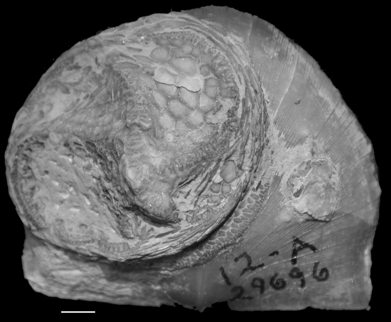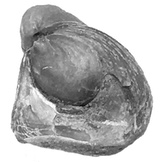Isorophus

Isorophus cincinnatiensis
MUGM 29696
scale bar is 4 mm
Like Carneyella and Curvitriordo, Isorophus has relatively long and curved ambulacra, one of which is curved clockwise. Isorophus is distinguished by the presence of ambulacral plates that form double alternating biseries, rather than a single series as in Carneyella or a triple series as in Curvitriordo.
Species
Isorophus austini (Foerste, 1914)
Occurrence: Whitewater, Saluda, Elkhorn
Reference: Bell, 1976
Formerly Agelacrinus austini, Agelacrinites austini
Small domal theca, with relatively larger secondary ambulacral cover plates
Isorophus cincinnatiensis (Roemer, 1851)
Occurrence: Bellevue, Corryville, Arnheim, Whitewater
Reference: Bell, 1976; Bell, 1979; Ausich, 1996
Formerly Agelacrinus cincinnatiensis, Agelacrinites cincinnatiensis, Carneyella cincinnatiensis, Lepidodiscus cincinnatiensis; Includes Agelacrinus holbrooki, Isorphus holbrooki, Carneyella holbrooki
Moderate to large domal theca, with relatively smaller secondary ambulacral cover plates
Isorophus warrenensis (James, 1883)
Occurrence: Fairmount, Arnheim, Waynesville
Reference: Bell, 1976
Formerly Agelacrinus warrenensis, Agelacrinites warrenensis
Small to moderate sized theca; very large interambulacral plates

